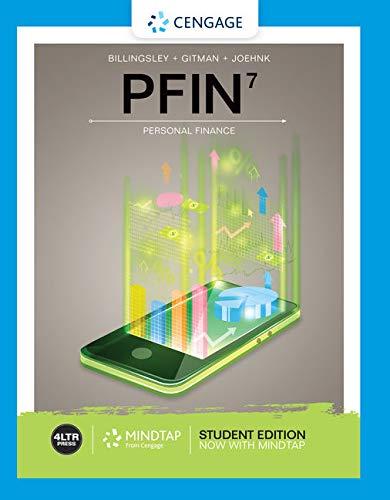
INVESTMENTS(LL)W/CONNECT
11th Edition
ISBN: 9781260433920
Author: Bodie
Publisher: McGraw-Hill Publishing Co.
expand_more
expand_more
format_list_bulleted
Question
Chapter 14, Problem 16PS
Summary Introduction
To Discuss:
Whether a bond is selling above or below par value when it has a current yield of 9% and a yield to maturity of 10%
Introduction:
A bond is a security that creates an obligation on the issuer to make specified payments to the holder for a given period of time.
The face
Yield to maturity is defined as the discount rate that makes the present payments from the bond equal to its price. In simple terms, it is the average
Expert Solution & Answer
Want to see the full answer?
Check out a sample textbook solution
Students have asked these similar questions
You invest $1,000 a year for 10 years at 6 percent and then invest $2,000 a year for an additional 10 years at 6 percent. How much will you have accumulated at the end of the 20 years?
Answer: $49,967
*Please include all work & formulas
No ai please!
What is the role of an underwriter in an IPO?A) To lend money to the companyB) To set the dividend policyC) To buy the securities and sell them to the publicD) To manage the company’s operations
need he
No ai tool
What is the role of an underwriter in an IPO?A) To lend money to the companyB) To set the dividend policyC) To buy the securities and sell them to the publicD) To manage the company’s operations
Chapter 14 Solutions
INVESTMENTS(LL)W/CONNECT
Ch. 14 - Prob. 1PSCh. 14 - Prob. 2PSCh. 14 - Prob. 3PSCh. 14 - Prob. 4PSCh. 14 - Prob. 5PSCh. 14 - Prob. 6PSCh. 14 - Prob. 7PSCh. 14 - Prob. 8PSCh. 14 - Prob. 9PSCh. 14 - Prob. 10PS
Ch. 14 - Prob. 11PSCh. 14 - Prob. 12PSCh. 14 - Prob. 13PSCh. 14 - Prob. 14PSCh. 14 - Prob. 15PSCh. 14 - Prob. 16PSCh. 14 - Prob. 17PSCh. 14 - Prob. 18PSCh. 14 - Prob. 19PSCh. 14 - Prob. 20PSCh. 14 - Prob. 21PSCh. 14 - Prob. 22PSCh. 14 - Prob. 23PSCh. 14 - Prob. 24PSCh. 14 - Prob. 25PSCh. 14 - Prob. 26PSCh. 14 - Prob. 27PSCh. 14 - Prob. 28PSCh. 14 - Prob. 29PSCh. 14 - Prob. 30PSCh. 14 - Prob. 31PSCh. 14 - Prob. 1CPCh. 14 - Prob. 2CPCh. 14 - Prob. 3CPCh. 14 - Prob. 4CPCh. 14 - Prob. 5CP
Knowledge Booster
Learn more about
Need a deep-dive on the concept behind this application? Look no further. Learn more about this topic, finance and related others by exploring similar questions and additional content below.Similar questions
- Which of the following is a money market instrument?A) Treasury bondsB) Corporate bondsC) Commercial paperD) Common stock need help!!arrow_forwardFinance Subject.Which of the following is a money market instrument?A) Treasury bondsB) Corporate bondsC) Commercial paperD) Common stockarrow_forwardHelp please without use of AI. no What is the main purpose of financial ratios?A) To guarantee a company's profitabilityB) To evaluate a company's financial performance and healthC) To increase a company's stock priceD) To ensure a company's debts are eliminatedarrow_forward
- Please don't use ai tool If a stock’s beta is 1.5, what does this indicate?A) The stock is less volatile than the marketB) The stock is more volatile than the marketC) The stock is not correlated with the market D) The stock is risk-freearrow_forwardNo ai What is the primary function of a financial market?A) To set interest ratesB) To facilitate the transfer of funds between savers and borrowersC) To regulate the banking industryD) To manage the government’s budgetarrow_forwardno What is the main purpose of financial ratios?A) To guarantee a company's profitabilityB) To evaluate a company's financial performance and healthC) To increase a company's stock priceD) To ensure a company's debts are eliminatedarrow_forward
- please don't use chatgpt What happens to the value of money when inflation increases?A) The value of money increasesB) The value of money decreasesC) The value of money remains unchangedD) The value of money fluctuates randomly helparrow_forwardDo not use Ai tool What happens to the value of money when inflation increases?A) The value of money increasesB) The value of money decreasesC) The value of money remains unchangedD) The value of money fluctuates randomlyarrow_forwardNo AI tool. Which of the following best defines a bond's coupon rate?A) The market rate of interest on the bondB) The annual interest payment as a percentage of the bond's face valueC) The difference between the bond's face value and its market priceD) The total return from holding the bond to maturityarrow_forward
- No ai!! answer it A portfolio's risk can be reduced by: A) Investing in a single stock B) Diversifying investments across different asset classes C) Borrowing money to invest more D) Only investing in high-risk assets need help.arrow_forwardNo chatgpt! A portfolio's risk can be reduced by: A) Investing in a single stock B) Diversifying investments across different asset classes C) Borrowing money to invest more D) Only investing in high-risk assets need help!arrow_forwardNo chatgpt!! A portfolio's risk can be reduced by:A) Investing in a single stockB) Diversifying investments across different asset classesC) Borrowing money to invest moreD) Only investing in high-risk assetsarrow_forward
arrow_back_ios
SEE MORE QUESTIONS
arrow_forward_ios
Recommended textbooks for you
 Pfin (with Mindtap, 1 Term Printed Access Card) (...FinanceISBN:9780357033609Author:Randall Billingsley, Lawrence J. Gitman, Michael D. JoehnkPublisher:Cengage Learning
Pfin (with Mindtap, 1 Term Printed Access Card) (...FinanceISBN:9780357033609Author:Randall Billingsley, Lawrence J. Gitman, Michael D. JoehnkPublisher:Cengage Learning Intermediate Financial Management (MindTap Course...FinanceISBN:9781337395083Author:Eugene F. Brigham, Phillip R. DavesPublisher:Cengage Learning
Intermediate Financial Management (MindTap Course...FinanceISBN:9781337395083Author:Eugene F. Brigham, Phillip R. DavesPublisher:Cengage Learning

Pfin (with Mindtap, 1 Term Printed Access Card) (...
Finance
ISBN:9780357033609
Author:Randall Billingsley, Lawrence J. Gitman, Michael D. Joehnk
Publisher:Cengage Learning

Intermediate Financial Management (MindTap Course...
Finance
ISBN:9781337395083
Author:Eugene F. Brigham, Phillip R. Daves
Publisher:Cengage Learning
What is modified duration? | Dejargoned; Author: Mint;https://www.youtube.com/watch?v=5yLIybzb_OQ;License: Standard YouTube License, CC-BY